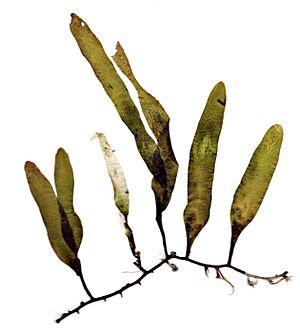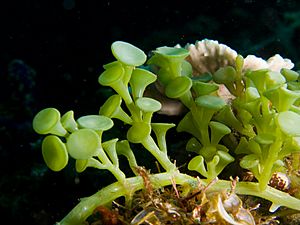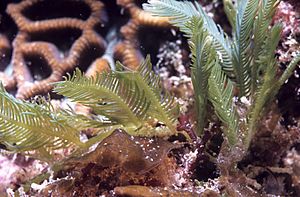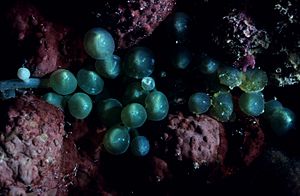Caulerpa facts for kids
Quick facts for kids Caulerpa |
|
|---|---|
 |
|
| Caulerpa prolifera | |
| Scientific classification |
|
| Phylum: | Chlorophyta |
| Class: | Ulvophyceae |
| Order: | Bryopsidales |
| Family: | Caulerpaceae |
| Genus: | Caulerpa J.V. Lamouroux, 1809 |
| Type species | |
| Caulerpa prolifera (Forsskål) J.V. Lamouroux, 1809
|
|
| Species | |
|
About 101 |
|
Caulerpa is a type of seaweed that belongs to the group called green algae. These seaweeds are quite special because each plant is actually just one giant cell! This single cell has many nuclei inside it, making Caulerpa one of the biggest single cells in the world. For example, one type found in the Mediterranean Sea can have a stem-like part called a stolon that is over 3 meters (10 feet) long, with up to 200 leaf-like parts called fronds. Some Caulerpa species can grow very fast and spread easily, becoming invasive species in new areas.
The name Caulerpa comes from ancient Greek words meaning 'stem that creeps'. This describes how these seaweeds grow by spreading along the seafloor.
Contents
What is Caulerpa?
Caulerpa was first described in 1809. It is the only group of seaweeds in its family, called Caulerpaceae. Scientists have identified about 101 different types, or species, of Caulerpa. It can sometimes be tricky to tell the species apart just by looking at them because they can look very different even within the same type. So, scientists often use special tests to identify them correctly.
How Caulerpa Lives
Caulerpa is unique because it's a single, giant cell. To keep everything working inside such a large cell, its cytoplasm (the jelly-like substance inside a cell) is always moving. This movement helps nutrients and other important things get to all parts of the cell. If a piece of Caulerpa is cut, the cytoplasm doesn't leak out. Instead, the plant can regrow, with roots (rhizoids) forming at the bottom and fronds at the top.
Caulerpa also makes special chemicals. Some of these chemicals give it a peppery taste and can be a bit toxic. This helps protect it from animals that might want to eat it.
What Caulerpa Looks Like
Caulerpa seaweeds come in many shapes and sizes. They all have a creeping stem (stolon) that grows along the bottom of the ocean. Small root-like parts called rhizoids grow downwards from the stolon, holding the plant in place. From the stolon, upright leaf-like parts called fronds grow upwards.
These fronds can look very different depending on the species:
- Some are flat and leaf-like, like Caulerpa prolifera.
- Others have a main stem with smaller branches called ramuli. These ramuli can be round, club-shaped, or even look like tiny grapes! For example, Caulerpa racemosa has bubbly, grape-like ramuli.
Inside Caulerpa
Even though Caulerpa is one big cell, it has special features inside. Unlike most plants where cells are separated by walls, Caulerpa is like one long tube filled with cytoplasm and many nuclei, all surrounded by a single cell wall. It also has tiny structures called trabeculae that grow inwards from the cell wall. These are thought to help support the plant and move nutrients around inside.
Where Caulerpa Grows
Caulerpa mostly lives in warm, tropical parts of the world. However, you can also find some types in cooler, temperate areas. The greatest variety of Caulerpa species is found in places like the Caribbean Sea, the Indo-Malay region, and southern Australia.
Caulerpa in its Environment
This seaweed usually grows in shallow coastal waters, but it can also be found as deep as 100 meters (about 330 feet). Caulerpa is very good at adapting to different environments. This is one reason why some species can become invasive.
Here are some reasons why Caulerpa can spread so easily:
- It can handle a wide range of temperatures.
- It can reproduce without needing a partner (called asexual reproduction). If a piece breaks off, it can grow into a whole new plant!
- It grows very quickly.
- It can get nutrients from the sand or mud through its roots (rhizoids), which gives it an advantage over other seaweeds that only get nutrients from the water.
Caulerpa as Food
Some types of Caulerpa are eaten by people! The two most popular edible species are Caulerpa lentillifera and Caulerpa racemosa. Both are often called "sea grapes" because of their shape. People in Southeast Asia, Oceania, and East Asia have traditionally collected them from the wild and sold them in local markets. They are usually eaten raw in salads and are known for their fresh "sea" flavor and crunchy texture.
Because they are so popular, these sea grapes are also grown on farms. Farming of C. lentillifera started in the Philippines in the 1950s. Later, in 1986, Japan began growing them in tanks in the warm waters of Okinawa. Now, commercial farming has spread to other countries like Vietnam, Taiwan, and China. Most of these sea grapes are eaten locally, but some are also sent to Japan.
Farming Caulerpa is quite easy because new plants can grow from small broken pieces. Farmers use different methods, like tying pieces to cages or trays in the ocean, or growing them in special tanks on land.
Other Uses of Caulerpa
Besides being a food source, Caulerpa has other interesting uses:
- Cleaning Water: Some species, like C. lentillifera, can help filter water in fish, mollusk, and shrimp farms, making the water cleaner.
- Fertilizer: Extracts from Caulerpa can be used as a natural fertilizer to help other plants grow better.
- Health Benefits: Scientists are studying compounds in Caulerpa for their potential health benefits, such as their antioxidant properties, which might help fight certain diseases.
Caulerpa as an Invasive Species
While some Caulerpa species are helpful, others can become a big problem when they are introduced to new places. For example, Caulerpa taxifolia has become an invasive species in the Mediterranean Sea, Australia, and parts of California (though it has been removed from California). In the U.S., this type of Caulerpa is considered a harmful weed.
One reason Caulerpa can be invasive in new areas is that it can grow well in cooler waters, and there are no natural predators to control it. In its native tropical waters, local plant-eating animals have developed ways to handle the toxins in Caulerpa. But in new, cooler places, the local animals don't have this protection, so Caulerpa can grow out of control.
Another species, C. racemosa, has also spread to waters around Crete and is thought to have harmed local fisheries. Caulerpa cylindracea, which is from Australia, has also become invasive in the Mediterranean. Recently, other types like Caulerpa brachypus and Caulerpa parvifolia have been found in New Zealand waters.
Caulerpa in Aquariums
Many people who have home aquariums use Caulerpa because it grows quickly and can help absorb nitrates, which are harmful chemicals in aquarium water. However, it's believed that some invasive Caulerpa species got into the wild because people dumped their aquarium contents into the ocean. Because of this risk, some aquarium hobbyists now use other types of algae or special filters instead.
Types of Caulerpa
There are many different species of Caulerpa. Here are some of them:
- Caulerpa agardhii
- Caulerpa alternans
- Caulerpa annulata
- Caulerpa antoensis
- Caulerpa articulata
- Caulerpa ashmeadii
- Caulerpa bartoniae
- Caulerpa bikinensis
- Caulerpa biserrulata
- Caulerpa brachypus
- Caulerpa brownii
- Caulerpa buginensis
- Caulerpa cactoides
- Caulerpa carruthersii
- Caulerpa chemnitzia
- Caulerpa cliftonii
- Caulerpa constricta
- Caulerpa corynephora
- Caulerpa crassifolia
- Caulerpa cupressoides
- Caulerpa cylindracea
- Caulerpa delicatula
- Caulerpa dichotoma
- Caulerpa diligulata
- Caulerpa distichophylla
- Caulerpa ellistoniae
- Caulerpa elongata
- Caulerpa falcifolia
- Caulerpa faridii
- Caulerpa fastigiata
- Caulerpa fergusonii
- Caulerpa filicoides
- Caulerpa filiformis
- Caulerpa flexilis
- Caulerpa floridana
- Caulerpa harveyi
- Caulerpa hedleyi
- Caulerpa heterophylla
- Caulerpa holmesiana
- Caulerpa imbricata
- Caulerpa juniperoides
- Caulerpa kempfii
- Caulerpa lagara
- Caulerpa lamourouxii
- Caulerpa lanuginosa
- Caulerpa lentillifera
- Caulerpa lessonii
- Caulerpa longifolia
- Caulerpa macrodisca
- Caulerpa macrophysa
- Caulerpa manorensis
- Caulerpa matsueana
- Caulerpa mexicana
- Caulerpa microphysa
- Caulerpa murrayi
- Caulerpa nummularia
- Caulerpa obscura
- Caulerpa okamurae
- Caulerpa oligophylla
- Caulerpa ollivieri
- Caulerpa opposita
- Caulerpa papillosa
- Caulerpa parvifolia
- Caulerpa parvula
- Caulerpa paspaloides
- Caulerpa peltata
- Caulerpa pickeringii
- Caulerpa pinnata
- Caulerpa plumulifera
- Caulerpa prolifera
- Caulerpa pusilla
- Caulerpa qureshii
- Caulerpa racemosa
- Caulerpa remotifolia
- Caulerpa reniformis
- Caulerpa reyesii
- Caulerpa scalpelliformis
- Caulerpa sedoides
- Caulerpa selago
- Caulerpa serrulata
- Caulerpa sertularioides
- Caulerpa seuratii
- Caulerpa simpliciuscula
- Caulerpa spathulata
- Caulerpa subserrata
- Caulerpa taxifolia
- Caulerpa trifaria
- Caulerpa urvilleana
- Caulerpa vanbossea
- Caulerpa veravalensis
- Caulerpa verticillata
- Caulerpa vesiculifera
- Caulerpa webbiana
- Caulerpa zeyheri
See also
 In Spanish: Caulerpa para niños
In Spanish: Caulerpa para niños





